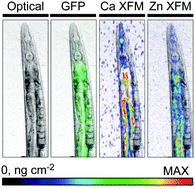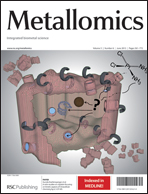Direct in vivo imaging of essential bioinorganics in Caenorhabditis elegans†
Abstract
Metals are essential in biochemistry, with highly regulated localisation and concentration. To continue elucidating the impact of inorganic physiology on cellular process in health and disease requires development of suitable eukaryotic models and experimental approaches. The multicellular organism Caenorhabditis elegans has been widely adopted as a model system and proved to be highly valuable in biomedical research, and here we record the distribution of physiologically important 4th row elements throughout anesthetised, hydrated adult C. elegans without the need for chemical fixation or mechanical sectioning. Probing the partitioning of elements between intact anatomical structures at subcellular length scales allowed the impact of preparation techniques commonly in use for analytical microanalysis to be assessed. In addition, taking advantage of C. elegans as a research tool, these studies were carried out across a cohort of genetically homogenous individuals with specific expression of green fluorescent


 Please wait while we load your content...
Please wait while we load your content...